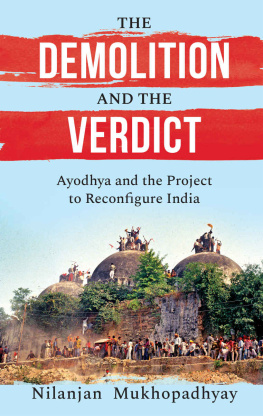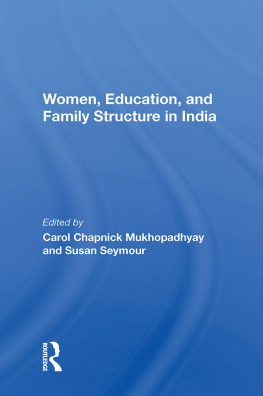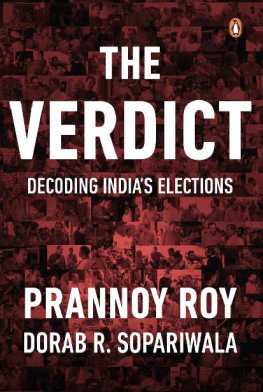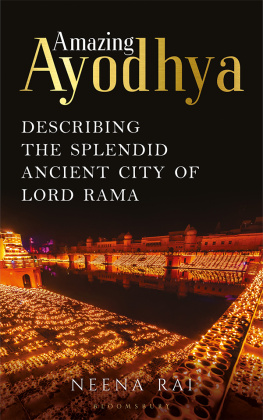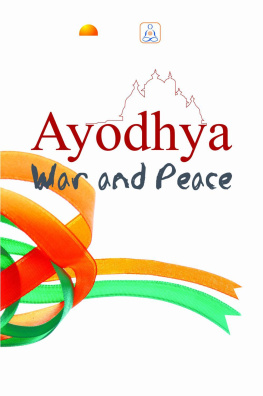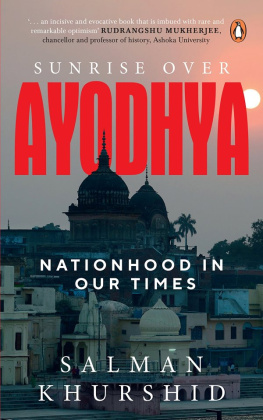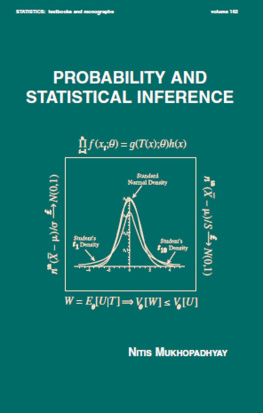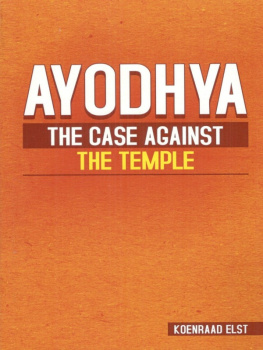Nilanjan Mukhopadhyay - THE DEMOLITION AND THE VERDICT AYODHYA AND THE PROJECT TO RECONFIGURE INDIA
Here you can read online Nilanjan Mukhopadhyay - THE DEMOLITION AND THE VERDICT AYODHYA AND THE PROJECT TO RECONFIGURE INDIA full text of the book (entire story) in english for free. Download pdf and epub, get meaning, cover and reviews about this ebook. year: 2021, genre: Politics. Description of the work, (preface) as well as reviews are available. Best literature library LitArk.com created for fans of good reading and offers a wide selection of genres:
Romance novel
Science fiction
Adventure
Detective
Science
History
Home and family
Prose
Art
Politics
Computer
Non-fiction
Religion
Business
Children
Humor
Choose a favorite category and find really read worthwhile books. Enjoy immersion in the world of imagination, feel the emotions of the characters or learn something new for yourself, make an fascinating discovery.
- Book:THE DEMOLITION AND THE VERDICT AYODHYA AND THE PROJECT TO RECONFIGURE INDIA
- Author:
- Genre:
- Year:2021
- Rating:4 / 5
- Favourites:Add to favourites
- Your mark:
- 80
- 1
- 2
- 3
- 4
- 5
THE DEMOLITION AND THE VERDICT AYODHYA AND THE PROJECT TO RECONFIGURE INDIA: summary, description and annotation
We offer to read an annotation, description, summary or preface (depends on what the author of the book "THE DEMOLITION AND THE VERDICT AYODHYA AND THE PROJECT TO RECONFIGURE INDIA" wrote himself). If you haven't found the necessary information about the book — write in the comments, we will try to find it.
THE DEMOLITION AND THE VERDICT AYODHYA AND THE PROJECT TO RECONFIGURE INDIA — read online for free the complete book (whole text) full work
Below is the text of the book, divided by pages. System saving the place of the last page read, allows you to conveniently read the book "THE DEMOLITION AND THE VERDICT AYODHYA AND THE PROJECT TO RECONFIGURE INDIA" online for free, without having to search again every time where you left off. Put a bookmark, and you can go to the page where you finished reading at any time.
Font size:
Interval:
Bookmark:

The Demolition and the Verdict
ALSO BY NILANJAN MUKHOPADHYAY
The Demolition: India at the Crossroads (1994)
Narendra Modi: The Man, The Times (2013)
Sikhs: Untold Agony of 1984 (2015)
The RSS: Icons of the Indian Right (2019)

Contents
In memory of those who died in the name of religion
And
For Varsha
An enduring companionship through all trials and tribulations.
Introduction
To guide a sun beam or create a sun
To rule ten thousand thousand worlds, or none,
Go, worlds! said God; but learn, ere ye depart,
My favourite temple is an humble heart...
Phillip James Bailey
T he writing of this book was begun around the time when it became evident, during the autumn of 2019, that judicial adjudication of the decades-old temple-mosque dispute in Ayodhya was at long last a certainty. Work on its closure coincided with the declaration that the new Ram temple would be thrown open to devotees in December 2023. The de facto inaugural would strike the opening notes of a triumphalist symphony, which would reach its crescendo when political campaigning for Indias scheduled parliamentary election in 2024 nears its conclusion. In more ways than one, devotees lining up to enter the new Ram temple would not just mark a complete circle but also begin a new trajectory, the direction of which remains uncertain at the moment. Much of the path traversed since the early 1980s has been in the name of respective gods. Ironically, people in contemporary India mainly assert their religious identities in a way that is an exact antithesis of moral teachings of any religion. Despite repeating ad nauseam the Vedic phraseEkam sat, vipraha bahuda vadanti (Truth is one, wise men describe it variously), most still assert that only their way of reaching the truth is the correct path.
The two-year period, beginning in the third quarter of 2019-20, witnessed humans grappling with the worst existential crisis of the century. Questions of survival in the wake of Covid-19 became uppermost in everyones minds from early 2020. The subconscious mind probingly asked if anyone amid the current crises could be concerned about a temple-mosque dispute? But contempt and hatred for the Other continued flowing unabated in political and policy narratives. When it became evident that politicians continue to whip up social discord in order to reap political benefits, realisation dawned that there is never a moratorium on propagation of hatred. With politicos pursuing polarising programmes, regardless of the devastating impact of the pandemic on citizens, and whipping up superstition instead of nurturing scientific temper in society, why should critical and reasoned writing on matters that determine the future character of the Indian republic cease?
The aforementioned period also witnessed a number of core objectives of Hindutva getting more or less fulfilled. The list is extensive, immensely gratifying for supporters, profoundly unsettling for adversaries. Indias most unwavering swerve towards constitutional majoritarianism began after the BJP secured an enhanced electoral mandate in May 2019. The sense of we can do anything generated by it, first became evident in the governments decision to harshen Indias pre-existing anti-terrorism law, the Unlawful Activities (Prevention) Act (UAPA), first enacted in 1967, but subsequently braced up on several occasions by various governments. This coincided with enactment of the Muslim Women (Protection of Rights on Marriage) Act, 2019, ostensibly to ameliorate the standing of Muslim women within wedlock, but in essence to transmit a clear message to the BJPs core Hindu constituencythat the government was chipping away at privileges of the stereotypical Muslim male.
The governments subsequent decision, nullifying constitutionally-pledged autonomy for Jammu and Kashmir, brought to fruition the BJPs promise for complete integration of the once princely territory into the Indian Union. It sent the signal that in its renewed tenure, the BJP would not limit its mandate to administrative measures and shy away from major alterations to the Constitution. While abrogation of Article 370 was part of the three core issues that were pursued by the sangh parivar for decades, other steps that followed relentlessly could not have been taken had the doorway not been opened by the success of the Ayodhya movement. Whether it was the union governments decision to link citizenship with religious identity by amending the law under CAA, or the actions of several BJP-governed states to curtail religious conversions, illegalise beef consumption, its storage and trade, make inter-faith marriages administratively tedious and socially perilous and disincentivise families with more than two children, each decision was taken with the objective of sending the message that this government had put an end to the practise of appeasing Muslims and shown them their place in the national hierarchy.
The Ayodhya movement is unprecedented in the annals of Indian history. The success of the sangh parivar lies in having ensured that the passion and paranoia aroused in the course of the agitation for the Ram temple, was not limited to merely demolishing the Babri Masjid and constructing a new temple in its place. In addition to it, sentiments stirred in the minds of a large section of Hindus have become integral in their psyche. From a time when the dominant section of Hindus was in principle, of the view that it was obligatory for the majority to safeguard the interests of the minorities, the same people have now begun to think that the obligation is on minorities, to ensure that sentiments of the majority are not hurt. The quote attributed, in a personal conversation, to his mother by a celebrated filmmaker of inter-religious parentage, persistently ricochets deep within the confines of the mind: Yeh mulq unka hai (this country is theirs).
The consensus on Indias heterogeneity, multiplicity and complexity has been altered in the course of the Ayodhya agitation. The mosque that existed pre-1992 was successfully depicted as the symbol of a past that had to be undone. With this limited objective now fulfilled, there is greater support for seeing the country and its people from a single national-identity majoritarian perspective. An enhanced agreement now exists for the argument that the majority community, or their representatives, have the primary right to decide what constitutes political and social correctness. It follows from this that minorities, while having the right to live in this country, must adhere to terms set by the dominant community. From a time when social integration was encouraged, there is now a push towards compartmentalisation and existence in respective boxes, coming out during work hours for collective activities, but thereafter retreating to our respective ghettos. We can even say that this Gujarat model has become pan-Indian. The Ram temple may have been won, but much remains to be donethis sense drives a significant section of people.
India was not a land of perpetual hostility, a territory constantly labelling people as them and us. Yet, a primary discordance existed in social discourse on how we defined the nation and nationhood, in terms of people and their unitary culture (which is also religion), or as home to a pluralistic society. Differences, divergences, even phases long and briefof conflict persisted after Independence. But, the India in which I became socially and politically aware primarily prided itself on its diversity. For a member of the generation of pre- and early teenagers who witnessed the liberation of Bangladesh and events that followed within India, these developments demonstrated the correctness of choice of the founding fathers for steering the nation on a path paved with the principles of secularism, democracy and egalitarianism. After 1971, banter in school was always marked by a sense of one-upmanship insofar as Pakistan was concerned, not for military reasons alone, but for our social character, because religion was not the primary basis of our social identity. Unlike them, we were a nation for all. Likewise, we prided ourselves for being part of the same school assembly despite being pro- or anti-Indira Gandhi, during Emergency and in 1977, as even Pakistan and Bangladesh saw democracy crumbling. In the small north Indian campus town where I grew up, the muezzins call as well as the temples gongs were heard without sounding intrusive to anyone.
Next pageFont size:
Interval:
Bookmark:
Similar books «THE DEMOLITION AND THE VERDICT AYODHYA AND THE PROJECT TO RECONFIGURE INDIA»
Look at similar books to THE DEMOLITION AND THE VERDICT AYODHYA AND THE PROJECT TO RECONFIGURE INDIA. We have selected literature similar in name and meaning in the hope of providing readers with more options to find new, interesting, not yet read works.
Discussion, reviews of the book THE DEMOLITION AND THE VERDICT AYODHYA AND THE PROJECT TO RECONFIGURE INDIA and just readers' own opinions. Leave your comments, write what you think about the work, its meaning or the main characters. Specify what exactly you liked and what you didn't like, and why you think so.

